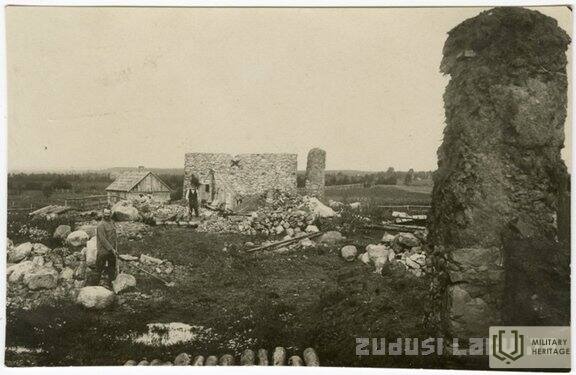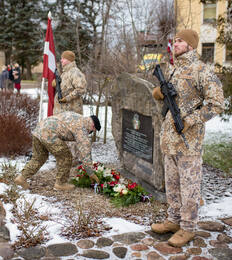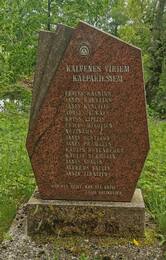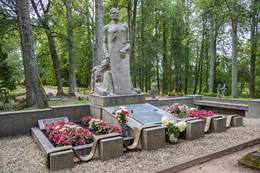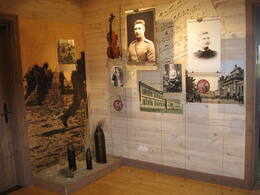Skrunda Battle I WW1, I Wars of Independence
An offensive launched by the Latvian National Guard, which took place on 29 January 1919, aimed at capturing the town of Skrunda.
The participants of the battle included the Instructor Company of the Latvian Independent Battalion and the Cēsis Company in addition to the Russian Company and one company of the German Infantry Battalion. Half of the German Artillery Battery aided in the attack.
The 1st battalion of the 2nd Soviet Latvian Rifle Regiment was in the vicinity of Skrunda Manor. The attack began at 4 a.m. and at 11 a.m. the enemy started to withdraw from Skrunda Church and Skrunda Manor.
The Skrunda Battle was the first successful attack by the Provisional Government's Armed Forces in the War of Independence.
More information sources
Lost Latvia - Battlefield of the Latvian Freedom Fights at Skrunda Manor (zudusilatvija.lv)
Related timeline
Related objects
Battle of Skrunda Memorial and Flag Day
The Skrunda Battle Memorial is located in the centre of Skrunda, in Oskaras Kalpaka Park near the Skrunda Culture House, at the intersection of Kuldīgas and Liepājas Streets. In 2005, a stone was erected at the memorial commemorating the battle of 29 January 1919, when the battalion commanded by Oskars Kalpaks, together with the German and Russian units of the Landeswehr, liberated Skrunda from the Bolsheviks. The tradition of Flag Day has been maintained since 2004, commemorating the first town liberated from the Bolsheviks and its liberators, who raised the Latvian flag at the Skrunda church on 29 January 1919.
During the first months of the War of Independence, the Latvian Provisional Government, under pressure from the Bolsheviks, was rapidly losing territory. On 22 January 1919, the Bolsheviks captured Skrunda. A week later, in the early hours of 29 January, the offensive to recapture Skrunda began. The Latvian Separate Battalion under Lieutenant Colonel Oskars Kalpaks was to attack along the Rudbāržu-Skrunda highway and drive the Bolsheviks out of Skrunda. This would be followed by a flank attack by German units with the task of destroying the advancing enemy, while the Russian company would attack between the Latvian and German units, using the Skrunda church as a landmark. The attack was also supported by a German artillery battery. On the day of the attack, the frost was 15 degrees, the sun shone brightly, the Kalpaks had to cross a clear field, and the Bolsheviks were sheltering in the stone buildings of the manor. The Bolsheviks opened fire when the chain of attackers was about 300 metres away, a two-way firefight broke out, and the soldiers under Oskars Kalpaks' command advanced in a rapid advance, forcing the enemy to cease fire and retreat across the Venta. After about 3 hours of fighting, Skrunda was captured at about 9am, with the Latvian Separate Battalion having only 2 wounded.
The Battle of Skrunda was of great importance for the morale of the Latvian Provisional Government's armed Spek soldiers, as it was in fact the first significant victory in the battles against the Bolsheviks. Moreover, the commander himself, Oskars Kalpaks, showed particular courage in the battle, encouraging the soldiers by his example not to be afraid.
Monument and memorial markers to the soldiers of O. Kalpaka Battalion at Aizpore Cemetery
About halfway between Rudbārži and Kalvė, on the side of an old road parallel to the A9 highway, is the Aizpore Cemetery.
There is a monument and 12 memorials to the volunteer soldiers of Oskars Kalpaka's battalion, who lived in the surrounding houses.
The Aizpore half-manor of the Kalvene municipality was the farthest place to which the Latvian Separate (Kalpaka) Battalion retreated on 22 January 1919. Here the battalion received its first reinforcements from Liepāja - 35 men and launched a counter-attack, reaching Rudbārži on 24 January.
The idea of erecting a monument was conceived in the 1920s, when former soldiers of the 1st Latvian Separate Battalion, or Kalpaka Battalion, erected a temporary memorial sign - a block of oak with a plaque. At that time, the idea of creating a larger memorial ensemble was born, but it was only realised on 15 May 1993, when the memorial sign - the Ray of Light - was unveiled - an obelisk made of grey granite.
The 2.3 m high memorial sign is made by sculptors Harijs SPRINCIS and Imants LUKAŽIS (1930 - 2007, buried in Aizpuri Cemetery), whose father was also a soldier of O. Kalpaka's battalion. The names of the poet E.VIRZA are engraved on the memorial sign:
KALPAKAM
AND HIS
TO THE SOLDIERS
1919
MORNING OF 25 JANUARY
FROM THIS DAY
ALSO FROM
FIRE
OVER LATVIA
At the same time, the graves of the 12 Kalpaks buried in the cemetery were marked with oak memorial plaques, which were replaced by granite markers in 2019.
In the early 1990s, a two-metre-high monument was erected in the cemetery, next to which grows an oak tree planted in the mid-1990s by the legendary actor Ēvalds Valters.
The last resting place of Colonel Oskars Kalpaks
Located in Visagala Cemetery, Madona district
On July 10, 1927, a monument made by Kārlis Zāle and Arnolds Dzirkaļs was unveiled to Oskars Kalpaks - a composition of three figures, in the center of which is an ancient Latvian warrior with a shield and a sword in his hand, but on both sides is a wielding soldier. At the foot of the sculptural group, a bronze plaque is placed on the granite base, with a text engraved on it, which also includes a poem by Edward Virza dedicated to Kalpak.
Oskars Kalpaks fell in 1919. On March 6, near "Airīte", on the side of Skrunda - Saldus road, on September 18, his remains were transferred from the northern cemetery of Liepāja to the family cemetery in Visagala.
The monument was unveiled by General J. Balodis, Chairman of the Monument Committee of Colonel O. Kalpaks, with the participation of the then President G. Zemgale, Prime Minister M. Skujenieks, Speaker of the Saeima P. Kalniņš, Minister of War R. Bangerskim and K. Ulmanis. The foundation stone of the monument was laid on June 19, 1925. The stone for the monument is taken from the colonel's native house in Siena swamp, O. Kalpaks loved to play the violin on this stone as a child.
Oskars Kalpaks Museum and Memorial Site “Airītes”
The Oskars Kalpaks Museum and Memorial Site Airītes is located between Saldus and Skrunda near the A9 highway. The exhibit has extensive information about Colonel Oskars Kalpaks and his battalion, and shows the history of the Latvian National Army and the memorial site Airītes. The exhibit reveals Colonel Oskars Kalpaks as a personality, as a soldier and as a fighter for Latvia's independence. Audio logs in Latvian, English and German are also available as part of the exhibit. They emphasize the importance of the historic events of 1918/1919 in the protecting the statehood of Latvia. The museum building has been restored.
Entry is free; guided tour – for a fee. The complex has a recreation area, a park, an obstacle course, it is possible to take various classes, and there is a seminar hall for up to 30 people.
Related stories
Aizporu half manor in the War of Independence
Aizporu Half Manor, Aizpute district, Kalvene municipality, is the westernmost place in Latvia to which Colonel Oskars Kalpaks' separate battalion retreated.
Halfway between Rudbārži and Kalvenė, on the side of the road, is the Aizpore cemetery. There is a monument and 12 memorials to the volunteer soldiers of Oskars Kalpaka's battalion.




